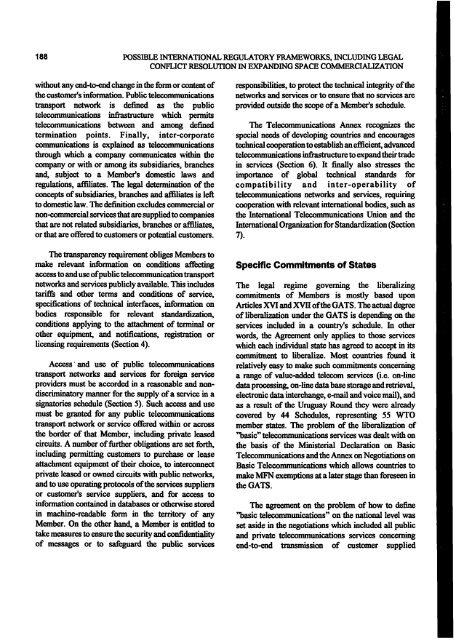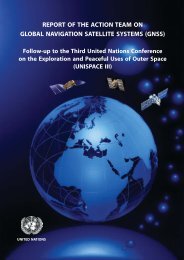Proceedings of the Workshop - United Nations Office for Outer ...
Proceedings of the Workshop - United Nations Office for Outer ...
Proceedings of the Workshop - United Nations Office for Outer ...
- No tags were found...
You also want an ePaper? Increase the reach of your titles
YUMPU automatically turns print PDFs into web optimized ePapers that Google loves.
188 POSSIBLE INTERNATIONAL REGULATORY FRAMEWORKS, INCLUDING LEGALCONFLICT RESOLUTION IN EXPANDING SPACE COMMERCIALIZATIONwithout any end-to-end change in <strong>the</strong> <strong>for</strong>m or content <strong>of</strong><strong>the</strong> customer's in<strong>for</strong>mation. Public telecommunicationstransport network is defined as <strong>the</strong> publictelecommunications infrastructure which permitstelecommunications between and among definedterm ination points. F inally, inter-corporatecommunications is explained as telecommunicationsthrough which a company communicates within <strong>the</strong>company or with or among its subsidiaries, branchesand, subject to a Member's domestic laws andregulations, affiliates. The legal determination <strong>of</strong> <strong>the</strong>concepts <strong>of</strong> subsidiaries, branches and affiliates is leftto domestic law. The definition excludes commercial ornon-commercial services that are supplied to companiesthat are not related subsidiaries, branches or affiliates,or that are <strong>of</strong>fered to customers or potential customers.The transparency requirement obliges Members tomake relevant in<strong>for</strong>mation on conditions affectingaccess to and use <strong>of</strong> public telecommunication transportnetworks and services publicly available. This includestariffs and o<strong>the</strong>r terms and conditions <strong>of</strong> service,specifications o f technical interfaces, in<strong>for</strong>mation onbodies responsible <strong>for</strong> relevant standardization,conditions applying to <strong>the</strong> attachment <strong>of</strong> terminal oro<strong>the</strong>r equipment, and notifications, registration orlicensing requirements (Section 4).Access and use o f public telecommunicationstransport networks and services <strong>for</strong> <strong>for</strong>eign serviceproviders must be accorded in a reasonable and nondiscriminatorymanner <strong>for</strong> <strong>the</strong> supply <strong>of</strong> a service in asignatories schedule (Section 5). Such access and usemust be granted <strong>for</strong> any public telecommunicationstransport network or service <strong>of</strong>fered within or across<strong>the</strong> border <strong>of</strong> that Member, including private leasedcircuits. A number o f fur<strong>the</strong>r obligations are set <strong>for</strong>th,including permitting customers to purchase or leaseattachment equipment o f <strong>the</strong>ir choice, to interconnectprivate leased or owned circuits with public networks,and to use operating protocols <strong>of</strong> <strong>the</strong> services suppliersor customer's service suppliers, and <strong>for</strong> access toin<strong>for</strong>mation contained in databases or o<strong>the</strong>rwise storedin machine-readable <strong>for</strong>m in <strong>the</strong> territory o f anyMember. On <strong>the</strong> o<strong>the</strong>r hand, a Member is entitled totake measures to ensure <strong>the</strong> security and confidentialityo f messages or to safeguard <strong>the</strong> public servicesresponsibilities, to protect <strong>the</strong> technical integrity o f <strong>the</strong>networks and services or to ensure that no services areprovided outside <strong>the</strong> scope <strong>of</strong> a Member's schedule.The Telecommunications Annex recognizes <strong>the</strong>special needs o f developing countries and encouragestechnical cooperation to establish an efficient, advancedtelecommunications infrastructure to expand <strong>the</strong>ir tradein services (Section 6). It finally also stresses <strong>the</strong>importance o f global technical standards <strong>for</strong>c o m p a tib ility and in te r-o p e ra b ility o ftelecommunications networks and services, requiringcooperation with relevant international bodies, such as<strong>the</strong> International Telecommunications Union and <strong>the</strong>International Organization <strong>for</strong> Standardization (Section7).Specific Commitments <strong>of</strong> StatesThe legal regime governing <strong>the</strong> liberalizingcommitments o f Members is mostly based uponArticles XVI and XVII o f <strong>the</strong> GATS. The actual degreeo f liberalization under <strong>the</strong> GATS is depending on <strong>the</strong>services included in a country's schedule. In o<strong>the</strong>rwords, <strong>the</strong> Agreement only applies to those serviceswhich each individual state has agreed to accept in itscommitment to liberalize. Most countries found itrelatively easy to make such commitments concerninga range o f value-added telecom services (i.e. on-linedata processing, on-line data base storage and retrieval,electronic data interchange, e-mail and voice mail), andas a result o f <strong>the</strong> Uruguay Round <strong>the</strong>y were alreadycovered by 44 Schedules, representing 55 WTOmember states. The problem <strong>of</strong> <strong>the</strong> liberalization <strong>of</strong>”basic” telecommunications services was dealt with on<strong>the</strong> basis o f <strong>the</strong> Ministerial Declaration on BasicTelecommunications and <strong>the</strong> Annex on Negotiations onBasic Telecommunications which allows countries tomake MFN exemptions at a later stage than <strong>for</strong>eseen in<strong>the</strong> GATS.The agreement on <strong>the</strong> problem o f how to define”basic telecommunications” on <strong>the</strong> national level wasset aside in <strong>the</strong> negotiations which included all publicand private telecommunications services concerningend-to-end transmission <strong>of</strong> customer supplied
















